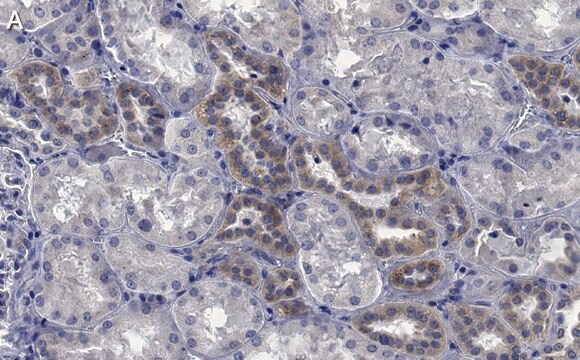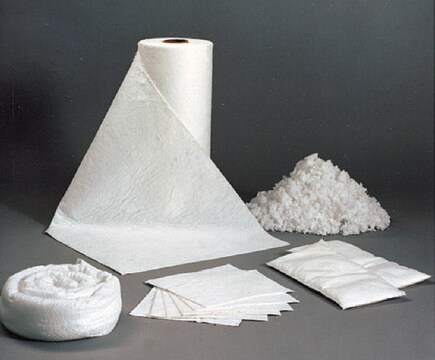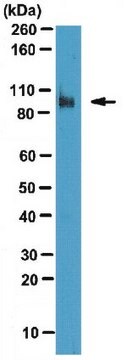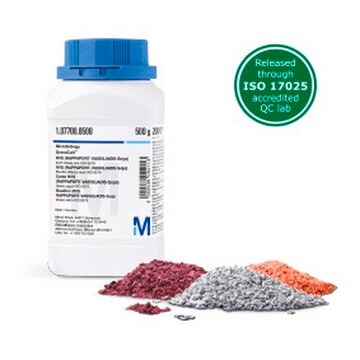おすすめの製品
由来生物
rat
品質水準
結合体
unconjugated
抗体製品の状態
purified antibody
抗体製品タイプ
primary antibodies
クローン
ER-TR5, monoclonal
化学種の反応性
human, mouse
包装
antibody small pack of 100 μg
テクニック
immunofluorescence: suitable
immunohistochemistry (formalin-fixed, paraffin-embedded sections): suitable
アイソタイプ
IgM
エピトープ配列
Unknown
UniProtアクセッション番号
輸送温度
2-8°C
ターゲットの翻訳後修飾
unmodified
詳細
The thymus is considered as the primary lymphoid organ that is responsible for the generation and maturation of T cells. Thymic epithelial cells account for the majority of thymic stromal components. These cells can be divided into cortical and medullary thymic epithelial cells based on their localization within the thymus. Cortical thymic epithelial cells are essential for the positive selection of T cells, whereas the medullary thymic epithelial cells (mTEC) play a role in inducing negative selection of highly reactive T cells that are required for establishing central self-tolerance. In murine species, mTEC are further divided into mTEC low and mTEC high according to the expression levels of several maturation molecules, such as MHCII and CD80. mTEC low cells can serve as precursors for mature mTEC high cells. mTECs have also been classified into four major subsets, termed mTEC I-IV depending on their distinct transcriptional and molecular characteristics. mTEC I and II subpopulation appear early and can be detected at E18.5 and are most proliferative cells. mTEC III are detected in thymus at 4-weeks. mTEC IV are visible on day 6 in neonatal mice. The function of mTECs is dependent on their characteristic features such as ectopic expression of peripheral tissue restricted antigens and their master regulator-autoimmune regulator (Aire), expression of various chemokines and cytokines. Lymphotoxin β receptor (LTβR) is reported to be an essential regulator of multiple mTEC subsets within the mTEC low compartment. It controls thymic tolerance by regulating the frequency and makeup of intrathymic dendritic cells that are required for effective thymocyte negative selection. Clone ER-TR5 is shown to exclusively react with mTECs. (Ref.: Wang, HX., et al. (2020). Front. Immunol. 10; 3099; Lucas, B., et al. (2020). Nat. Commun. 11; Article 2198; Cosway, EJ., et al. (2017). J. Exp. Med. 214(11); 3183-3195; Van Vliet, E., et al. (1984). Eur. J. Immunol. 14(6); 524-529).
特異性
Clone ER-TR5 is a rat monoclonal antibody that detects Medullary epithelial cells.
免疫原
Thymic stromal cells isolated from C3H mice.
アプリケーション
Quality Control Testing
Evaluated by Immunohistochemistry in Mouse thymus tissue.
Immunohistochemistry Applications: 1:150 dilution of this antibody detected Medullary epithelium in Mouse thymus tissue sections.
Tested applications
Immunofluorescence Analysis: A representative lot detected Medullary epithelium in Immunofluorescence applications (Akiyama, T., et al. (2005). Science. 308(5719):248-51; Lei, Y., et al. (2011). J Exp Med. 208(2):383-94; Cosway, E.J., et al. (2017). J Exp Med. 214(11):3183-3195).
Immunohistochemistry Applications: A representative lot detected Medullary epithelium in Immunohistochemistry applications (Van Vliet, E., et al. (1984). Eur J Immunol. 14(6):524-9; Akiyama, T., et al. (2005). Science.;308(5719):248-51; Dooley, J., et al. (2006). J Immunol. 176(11):6484-90; Lei, Y., et al. (2011). J Exp Med. 208(2):383-94; Cosway, E.J., et al. (2017). J Exp Med. 214(11):3183-3195).
Note: Actual optimal working dilutions must be determined by end user as specimens, and experimental conditions may vary with the end user
Evaluated by Immunohistochemistry in Mouse thymus tissue.
Immunohistochemistry Applications: 1:150 dilution of this antibody detected Medullary epithelium in Mouse thymus tissue sections.
Tested applications
Immunofluorescence Analysis: A representative lot detected Medullary epithelium in Immunofluorescence applications (Akiyama, T., et al. (2005). Science. 308(5719):248-51; Lei, Y., et al. (2011). J Exp Med. 208(2):383-94; Cosway, E.J., et al. (2017). J Exp Med. 214(11):3183-3195).
Immunohistochemistry Applications: A representative lot detected Medullary epithelium in Immunohistochemistry applications (Van Vliet, E., et al. (1984). Eur J Immunol. 14(6):524-9; Akiyama, T., et al. (2005). Science.;308(5719):248-51; Dooley, J., et al. (2006). J Immunol. 176(11):6484-90; Lei, Y., et al. (2011). J Exp Med. 208(2):383-94; Cosway, E.J., et al. (2017). J Exp Med. 214(11):3183-3195).
Note: Actual optimal working dilutions must be determined by end user as specimens, and experimental conditions may vary with the end user
Anti-Medullary epithelium, clone ER-TR5, Cat. No. MABF2818, is a rat monoclonal antibody that detects Medullary epithelium and is tested for use in Immunohistochemistry and Immunofluorescence.
物理的形状
Purified rat monoclonal antibody IgM in buffer containing 0.1 M Tris-Glycine (pH 7.4), 150 mM NaCl with 0.05% sodium azide.
保管および安定性
Recommended storage: +2°C to +8°C.
その他情報
Concentration: Please refer to the Certificate of Analysis for the lot-specific concentration.
免責事項
Unless otherwise stated in our catalog or other company documentation accompanying the product(s), our products are intended for research use only and are not to be used for any other purpose, which includes but is not limited to, unauthorized commercial uses, in vitro diagnostic uses, ex vivo or in vivo therapeutic uses or any type of consumption or application to humans or animals.
適切な製品が見つかりませんか。
製品選択ツール.をお試しください
保管分類コード
12 - Non Combustible Liquids
WGK
WGK 1
引火点(°F)
Not applicable
引火点(℃)
Not applicable
適用法令
試験研究用途を考慮した関連法令を主に挙げております。化学物質以外については、一部の情報のみ提供しています。 製品を安全かつ合法的に使用することは、使用者の義務です。最新情報により修正される場合があります。WEBの反映には時間を要することがあるため、適宜SDSをご参照ください。
Jan Code
MABF2818-100UG:
MABF2818-25UG:
試験成績書(COA)
製品のロット番号・バッチ番号を入力して、試験成績書(COA) を検索できます。ロット番号・バッチ番号は、製品ラベルに「Lot」または「Batch」に続いて記載されています。
ライフサイエンス、有機合成、材料科学、クロマトグラフィー、分析など、あらゆる分野の研究に経験のあるメンバーがおります。.
製品に関するお問い合わせはこちら(テクニカルサービス)







